#hessians
Text
Who Wants a Non-Hessian German Troops of the American Revolution Uniform Identification Flow Chart?
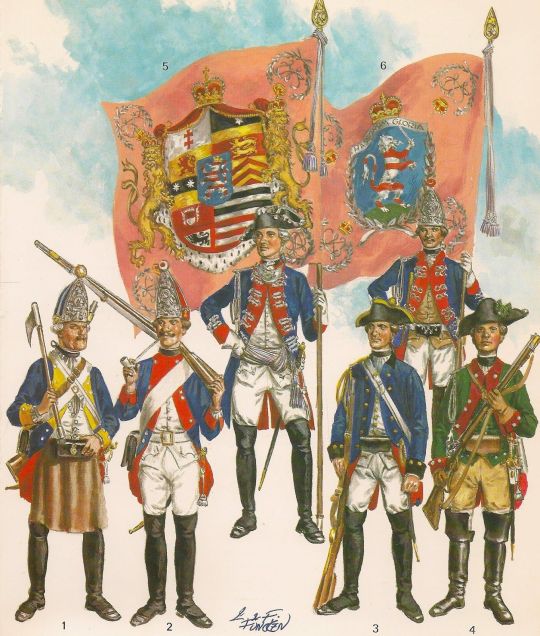
Now you too can roleplay as a harried British staff officer trying to identify which troops are encamped where, or a devious rebel spy collecting intelligence.
As folks may or may not know, only roughly 50% of the German state troops who served the British Crown during the American Revolution were “Hessians” from Hesse-Cassel. There were six other states that provided “subsidy troops.” Here’s how to tell them apart at a glance.
Are their uniforms predominantly dark blue? If yes, go to the paragraph numbered 4. If no, go to the para numbered 2.
2. Are their uniforms predominantly white? If no, go to the para numbered 3. If yes, those are troops from Anhalt-Zerbst. The only German state involved in the war to take its uniform and organisational cues from Austria rather than Prussia, the single Anhalt-Zerbst line regiment deployed to America wore white regimental coats faced with red. Their grenadiers wore bearskins rather than metal-faced caps (the only other German state to do this was Waldeck). One battalion also, according to one shocked British officer, had one of the most outrageous-looking uniforms of the war, including hussar hats, red and yellow waist sashes and red cloaks - these may have been “pandour” irregulars from the edges of the Austrian empire.

3. The coats are neither white nor blue, so they must be red. In this case, the troops are Hanoverian. While still mostly following Prussian style, because they shared a ruler with Britain, Hanoverian troops wore red. Five Hanoverian regiments assisted Britain with vital Mediterranean defence during the American Revolution, before going on to fight in India. They were the only redcoat Germans fighting for the Crown outside the British Army.
4. Your Germans are wearing blue coats. Are the buttons on the coat lapels arranged 1-2-1, and do the cuffs have a “Swedish” style slit to them? If no, go to the para numbered 5. If yes, they’re from Brunswick-Wolfenbüttel. Brunswick provided the most soldiers after Hesse-Cassel, and arguably the most rounded force, with four line regiments, one dragoon regiment, one grenadier battalion and one light infantry battalion. But whether jäger, musketeers or grenadiers, they almost all had coat buttons in groups of 1-2-1 and the slit-style cuffs. Fun fact; the Brunswick crest of a racing white horse on a red field was the same as neighbouring Hanover’s.

5. Your Germans are wearing blue, but don’t have buttons in 1-2-1 and Swedish cuffs. Do they have yellow facings, and cuffs with buttons placed both horizontally and vertically? If no, go to the para numbered 6. If yes, they are from Waldeck. This German state usually provided troops for the Dutch, but raised a new unit, the 3rd English-Waldeck Regiment, for service in America. They mostly fought against the Spanish in the Deep South, where they were decimated by disease. If the unusual position of the buttons on the cuff isn’t enough, look for the belt plate bearing “FF” for “Fuerst Friedrich,” the state’s ruler.
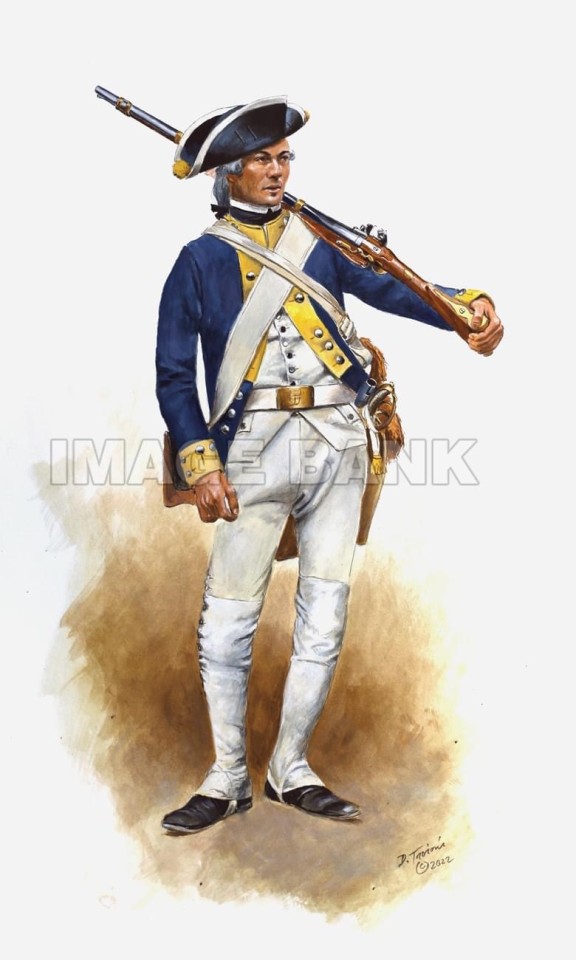
6. Do your blue Germans have red facings, cocked hats and unusual lace on their coats, shaped like a figure-of-eight? If no, go to the para numbered 7. If yes, they’re from Hesse-Hanau. This state was closely related (in the sense of its ruler, literally) to Hesse-Cassel, yet remained independent. While it provided a small amount of artillery, jägers and freikorps light infantry, its main contribution was a single line regiment, Erbprinz. Their distinctive features were scalloped lace on their cocked hats and the figure-of-eight “Brandenburg” style lace. There was also a Hesse-Cassel Regiment Erbprinz (even sharing the same colonel-in-chief), but they were fusiliers with caps rather than the Hesse-Hanau musketeers with their cocked hats. Check the mistake made by this artwork - these are Hesse-Hanau soldiers from the Infanterie Regiment Erbprinz, but they’re wearing Cassel fusilier caps. Bonus fact; Hanau and Cassel’s crest both features a rampant lion with red and white stripes, but there are subtle differences - they face opposite directions, the style of stripes are slightly different, and the Hanau lion lacks the Cassel one’s crown, but does wield a sword.

7. Do your blue-coated Germans have a black eagle on their flags and grenadier cap plates? If no, they’re probably from Hesse-Cassel. If yes, they’re from Ansbach-Bayreuth. This German state consisted of two provinces, Ansbach and Bayreuth (funny that). Besides jägers and some battalion guns, their main contribution was two infantry regiments, one from each of the two provinces. Their ruler’s crest was a black eagle, similar to the Prussian one.

Of course these posts don’t account for the uniforms of the jäger corps, or musicians, or any artillery, but it can serve as a rough guide. For the proper detail, you’ll have to buy my forthcoming book on the topic!
Also would be pretty cool if someone made an actual flow chart out of this, just saying!
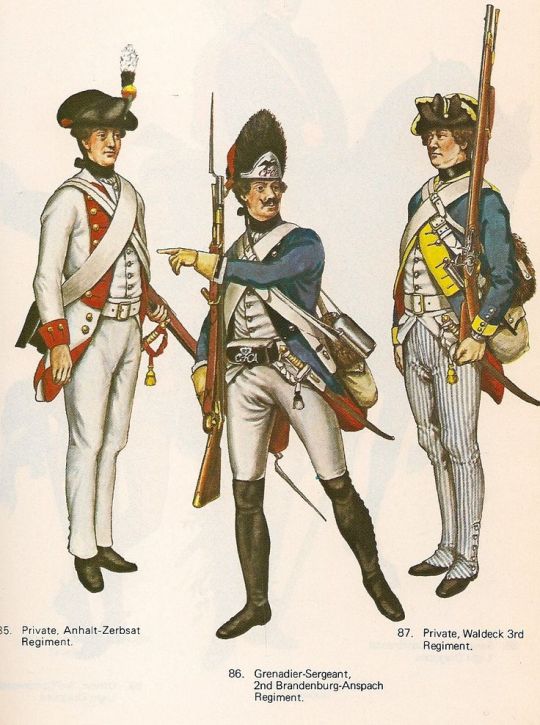
#hessian#hessians#german#germany#german army#german military#18th century#history#military history#american revolution#revwar#american war of independence
344 notes
·
View notes
Link
22 notes
·
View notes
Text
"a number of the Red Coats—and at the same time a large body of Hessians marched down opposite us..."
--John Woodhull, Princeton Class of 1766, August 20, 1776
5 notes
·
View notes
Text
"An officer of the Revolution": The story of Mountjoy Bayly [Part 1]

The Mountjoy Bayly House (also known as the Bayly House, Hiram W. Johnson House, Chaplains Memorial Building, Parkington, and Mott House) located at 122 Maryland Avenue, NE in the Capitol Hill neighborhood of Washington, D.C. Photograph courtesy of Wikimiedia. Mr. Bayly lived in this house while working as a doorkeeper and sergeant-at-arms in the US Senate, building it not before 1812, but sometime between 1817 and 1822. Currently, this is the headquarters of the Fund for Constitutional Government and the Stewart R. Mott Foundation. Previously it was the headquarters of the American Civil Liberties Union (ACLU)
This post continues the series on Maryland's Extra Regiment, focusing on the postwar lives of certain members of the unit whom information is plentiful about to explain wide-ranging trends. Mountjoy/Montjoy Bayly, whose last name can be spelled Bayley, Baley, Bailey, and Baillie, was not like unit commander Alexander Lawson Smith, who settled in Harford County until his death in 1802. Likely of Scottish origin, Mountjoy immigrated from Virginia, living in Frederick Town, within Frederick County. [1]
Reprinted from my History Hermann WordPress blog.
By the end of the war, in 1783, he had, for the time being, ended his varied military career. He served as an adjutant, and later a captain, in the 7th Maryland Regiment, from December 1776 to September 1778, when he resigned, sending George Washington a letter acknowledging this reality. [2] Within his duties as a captain, he fought at the Battle of Brandywine. On the day of the battle, on September 11, 1777, he led a patrol of Maryland soldiers wearing red coats, with a Quaker and "well-to-do farmer," named Joel Baily, thinking that they were the British and welcomed them heartily as a result. [3] However, Mountjoy soon would be out of commission for many years.
Within the sweltering weather and rough battle of Monmouth, in New Jersey, on June 18, 1778, he "broke a blood vessel" which rendered him "unfit for duty." He remained unable to "do duty until the Spring of 1780," sitting in a Pennsylvania hospital, as he said years later in his federal veterans pension application. [4] While he sat in the hospital, in an "unfortunate disposition," his regiment was ordered south, as he recalls. Even though he was later considered an "invalid," meaning that he had been injured in battle, he was still chosen as a captain in the Extra Regiment, which barely had a mention in his pension, only referenced in passing as the "additional regiment" of the Maryland Line. In later years, after serving in the Extra Regiment, he served as a recruiting officer in Frederick County and as "local city major and commandant of prisoners" in the town of Frederick as captured Hessian private Johann Conrad Döhla described him. [5] He placed people under arrest and oversaw Hessian prisoners, from 1781 to the end of the war. He even held a court-martial, in December 1781, in the town of Frederick since the officers commanding the militia in the county did not have, in his words, "the least Idea of discipline or indeed even distinction."
Mountjoy's life after the war

Fairfax County, Virginia (and surrounding counties) as pictured in Thomas Jeffery's 1755 map. Courtesy of the Library of Congress.
One year before the conclusion of the war, his father, William, died. However, Mountjoy still had many siblings and his mother, Mary, surviving him. He had six brothers (Pierce, William, Samuel, Joseph, Tarpley, and Robert), and three sisters (Sarah, Nancy, and Betty). [6] As a result of his father's death he may have inherited his father's land in Virginia, which likely included hundreds upon hundreds of acres. This is buttressed by the fact that Mountjoy was buying deeds to property in Fairfax County, Virginia in 1783 and 1784, along with part of a land agreement in 1782 with his father before his death. While Edward Papenfuse says he was entitled to 200 acres in Allegheny County for his service during the Revolutionary War, no record of his land plot in that county can currently be found. [7] However, Papenfuse may have a valid point in saying that he expanded his land holdings in Frederick County, including 47 acres of confiscated British property, and selling 192 acres between 1785 and 1805.
In 1784, Mountjoy cemented his ties with the Edelin/Edelen (Edelin is used in this article) family, prominent and wealthy within Frederick County, especially manifested in Christopher Edelin, a merchant who had become part of the local government in the county during the Revolutionary War. [8] As it turned out, Mountjoy married Elizabeth Edelin, the daughter of Christopher, with the connections between the two families continuing for years to come. He would have four children with Elizabeth, called by her first name in the rest of this article, named Benjamin, Richard, Eleanor, and Elizabeth. [9] Two land transactions the same year seems to indicate when Mountjoy was married. In September 1784, he paid a Baltimore merchant, Hugh Young, to buy a 450-acre tract known as "Victory" and later sold that same tract to Joseph Smith, who might be the son of the person it was originally surveyed for in 1773: Leonard Smith, when the tract consisted of 468 acres. [10] Since Elizabeth is not included on the first transaction, but is included on the second, this indicates she was possibly married to Mountjoy sometime between September 4 and 25.
Later in the 1780s, as Mountjoy continued to buy and sell land, Elizabeth would become more involved in these transactions, especially when it came to selling land. In December 1785, he bought the land on which his father-in-law, Christpher, previously mentioned, lived, which included a stone house and sat on a street in Frederick Town (present-day Frederick). [11] Not long after, he began his slave ownership, as much as we know. He bought an 19-year-old enslaved Black woman named "Pack" and an unnamed two-year-old enslaved Black female from Christopher. [12] These transactions were not surprising since Christopher would die the following year, 1786.
It would not be until 1787 that Elizabeth would agree with one of her husband's sales. He would sell land to numerous individuals, such as Joseph Young and George Scott, while buying land from Benjamin Dulany, mortgaging land to George Schuertzell and Peter Mantz, a former major of the Maryland Flying Camp, as the Bayly family lived comfortably in Frederick Town. [13] This included one piece of land called Salsbury/Salisbury Plains which was originally surveyed for Christopher in 1774, and consisted of 131 acres. By 1789, there was another change: Mountjoy re-entered the US military in 1789 as a major, the first of his forays back into the armed services. [14]
Mountjoy, the Maryland House of Delegates, the "Whiskey Rebellion," and French prisoners
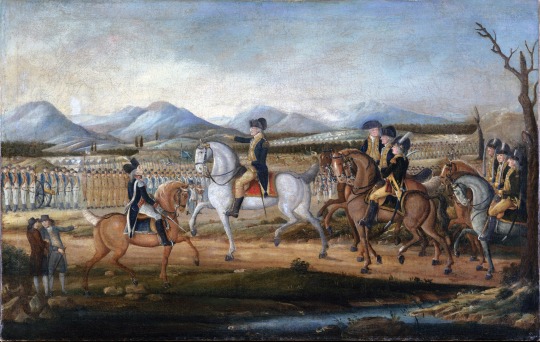
A 1795 painting reportedly by Frederick Kemmelmeyer titled "The Whiskey Rebellion" which depicts George Washington and his troops near Fort Cumberland, MD before they suppress the revolting farmers in western Pennsylvania. Image is courtesy of Wikimedia.
As a story goes, on June 13, 1791, George Washington ascended a hill in Frederick County and looked over the "beautiful Monocacy Valley." On that day, he was met by a "Cavalcade of Horsemen from Frederick" which included Mountjoy, and Colonel John McPherson, among others. [15] By this point, he had the political bug. While he had served as an auctioneer years earlier in Frederick County, it would not be until the mid-1780s and early 1790s he would serve as a delegate for Frederick County within the Maryland House of Delegates. [16] While serving as a legislator, he voted against creating a college on Maryland's Western shore, supported the prohibition of taxes to help "ministers of the gospel of any denomination," and helped prepare and bring in reports on inhabitants of Frederick Town and County. One year after his last legislative term, he rejoined the military as a brigadier general, serving in part of the Maryland Militia's Ninth Brigade, based in the upper part of Frederick County. [17]
While Mountjoy only served in the armed forces, for the fourth time, from 1794 to 1795, he was involved in a strong assertion of federal power. From 1791 to 1794, angry farmers, which some call "protesters," who declared themselves “Whiskey Boys,” attacked tax collectors in Pennsylvania, Georgia, Maryland, Virginia, North Carolina, and South Carolina. They did so because of the whiskey tax introduced by Secretary of Treasury Alexander Hamilton, calling, in part, for a more progressive tax code that didn't benefit the well-to-do. [18] Thomas Sim Lee, then the Governor of Maryland, organized state militia and "took an active part in the suppression of the Whisky Insurrection in western Pennsylvania and Maryland." Governor Lee ordered Mountjoy to rally local militia in the area, arm them, place a guard at the arsenal, and instruct another Maryland general, Smith, to raise a force of 800 men to "restore order." [19] By September 21, the rebelling farmers were dispersed, with most of them rounded up and turned over to the civil court system, as Governor Lee triumphantly told Hamilton. Mountjoy also met with Colonel Thomas Sprigg about guarding the "the magazine at Frederick." He wrote two letters about this. The first to Governor Lee, on September 10, with part of this letter describing the political environment in Western Maryland, specifically Washington and Allegheny counties where a "Spirit of disorder" existed, with "actual riots and disturbances":
I have thought it necessary to Send with the Arms &c Ordered to Allegany County a Strong Escort Consisting of one Complete Company. This I conceive will not be thought over cautious when your Excellency takes into View the existing Circumstances, these Arms &c will have to pass through Washington County Where the people are generally unfriendly to the present Views of the Government. Under this Idea of things I conceive it would be imprudent to risque the Supplies which you have Ordered.
Nine days later, Mountjoy wrote him another letter, in which he expanded on what he had said before:
In obedience to those orders, honoring me with the direction of the troops which your Excellency had commanded to rendezvouz at Frederick Town for the purpose of repressing that turbulent spirit which had violated peace & order and seemed to threaten Government itself in the Counties of Frederick Washington and Allegany...For that purpose I marched about 300 Infantry together with 70 horse through Harmans Gap which opens into the County of Washington near the Pennsylvania line, a rout which led me through the midst of those people whose turbulency it was your object to punish and repress. This was done with an intention to apprehend the characters who had been most active in their opposition to Governmt and whose names had been previously furnished to me for that purpose. It was supposed too that the appearance of an Armiment would have a very good effect, and convince those who had lost sight of their duty that Government could send forward a force at any time when necessity required it sufficient to inforce obedience to the Laws. On my arrival into Washington [County] I proceeded to carry into effect my arrangements by despatching the cavalry in quest of the Ringleaders. But upon the first display of the Horse, I found a party from Hagarstown [Hagerstown] had superceded the necessity of any exertion on my part, by having previously brought in those disorderly people to Justice. About the number of twenty [disorderly individuals] have been apprehended, all of which have been admitted to Bail except eight, these have not yet undergone their examination but most of them perhaps all of them will be committed to close Jail, without bail, however this is but opinion. Martin Bear and John Thompson had been examined before my arrival, and although both of them had been considered as notorious offenders they were admitted to Bail and to my great surprize Cols. [Thomas] Sprigg & [Rezin] Davis were their Securities. It is however but proper to add that upon the examination of these two men their was no evidence of their guilt save the general report as I am informed by those who were present [20]
Five years later, in September 1799, a captain in the First Regiment of Artillerists and Engineers, named Staats Morris (not the same as the British general of the same name) wrote to Hamilton about fifty French prisoners held by Mountjoy in Frederick Town. He says that
I have the honor to inform you that Lieut. Dyson returned from Frederick Town last night, having delivered the French prisoners (fifty in number) to Genl. Baily, as will appear by the enclosed receipt. By his report Lieut Newnan’s command is thought necessary as a guard over them. There have been several new cases of the fever at the fort since the date of my last letter; but from the report of the Surgeon and from the change in the weather, I am led to hope none will prove fatal. In my last letter I had the painful task of communicating to you the death of my young Kinsman, Lieut Lawrence Your letter received since containing orders for him (which I took the liberty of opening) has therefore been destroyed...[bottom:] enclosing Mountjoy Bayly’s receipt for fifty French prisoners
The same year, Mountjoy, a literate Presbyterian, planter, and "gentleman," would become a charter member of the Society of Cincinnati, a group of former revolutionary war officers. [21] Specifically, he would be one of the original members of the Society's branch in Maryland.
© 2016-2023 Burkely Hermann. All rights reserved.
#american revolution#revolutionary war#maryland#us history#battle of brandywine#1780s#hessians#extra regiment#regiment extra#maryland house of delegates#whiskey rebellion#1790s#society of cincinnati
0 notes
Text
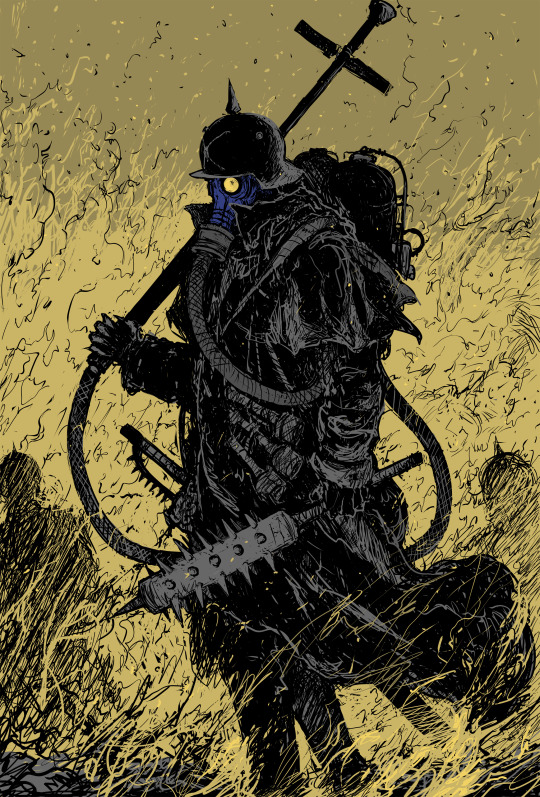

Burn the wolf
670 notes
·
View notes
Text

The Headless Horseman Pursuing Ichabod Crane
by John Quidor
#john quidor#art#headless horseman#ichabod crane#the legend of sleepy hollow#sleepy hollow#new york#tarrytown#american#america#north america#washington irving#folklore#gothic horror#gothic#horror#halloween#supernatural#story#hessian#ghost#ghosts#mythology#fairy tales#horse#horses#forest#wood#woods#landscape
440 notes
·
View notes
Text

@nasuversekinkmeme for the prompt "Something Izo and Barghest related, Romantic or otherwise"

bonus
#my comic#fate grand order#fgo#okada izou#barghest#gudako#ritsuka fujimaru#fk barghest#hessian lobo#well. half at least. decided to set it during the dog island event#ive never filled one of these before i was tempted to just add it to the rb ;-;#anyway idk if this is at all what the prompter wanted. ahah (scared)
383 notes
·
View notes
Text
ughhhh an Avenger class is a class of their own where not many humans- barely anyone would be able to handle them as they are impossible and incompatible with pan human history and so are one of the hardest to handle. to even be able to summon an Extra class outside of the seven accepted seats is a feat on its own but to form a bond and a strong one at that is a different thing entirely. to gain comforting words from Avengers that eternally burn with vengeance and hatred, to gain companionship and trust from Avengers mercilessly crushed and betrayed by the world, deemed as threats for their retaliation, hunted down as beasts and chased out of their homes with their loved ones killed, those who have also died alone, suffering from such a painful betrayal even when they themselves were faithfull all the way to the end. to gain an Avenger's love and loyalty, weapons that howl and cry and knows unfathomable pain and sorrow, a Class that never forgets, grudges and hatred in which are ingrained into their very existence yet love and compassion is what allows them to persist and keep on burning. as summoning such flames means you yourself are far more removed from "humanity" than anyone else.
#ughh guda gaining the love and understanding of avengers kills me on the spot#and isnt that a beautiful thing? to love so much that it changes you#to love and understand and be far more human than anyone else to the point where you yourself are considered inhuman to that thing which#represents “humanity” itself ughhhhhhhhhhhhhhh#fgo#fate grand order#what was in ordeal call ch 2 that has me like this istg#edmond dantes#hessian lobo#gorgon#jalter#antonio salieri#kagekiyo
78 notes
·
View notes
Text
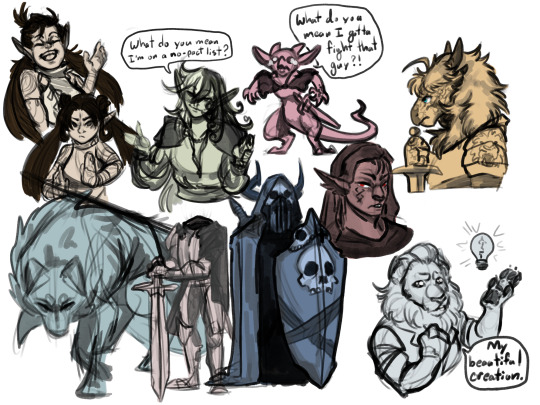
Sketches of Fate characters as DnD classes and races that I did with Fatedtime on stream for a Kinkmeme prompt! We talked with chat and came up with ideas for various characters with them, then drew them out.
(from top left to right)
Himiko and Iyo are traveling monks, with Iyo taking their jobs more seriously then Himiko over their travels.
Douman is an Eladrin Warlock pacting with as many patrons as they can to make a string of deals that mutually fuck over the various powers they've pacted with.
Sieg is a Kobold ranger who doesn't start very strong but Seigfried later transfers his magic powers into him and he gets much stronger and less terrified.
Berserker Cu is a Firbolg Barbarian.
Artoria is a Dragonborn/Leonin Paladin.
(from bottom left to right)
Lobo and Hessian are both Paladins, Lobo a Paladin of Vengeance and Hessian a Paladin of Remembrance. Lobo is a fey wolf (we were thinking like a blink dog) who travels in a party with Hessian enacting justice.
King Hassan is a Rouge/Cleric multiclass who's in a party with Hessian and Lobo. He misty steps behind their enemies before doing a sneak attack.
Edison would be a Leonin Artificer and be making a variety of helpful and mildy destructive inventions on his quests.
#kinkmeme#fgo#fate#himiko#iyo#artoria#berserker cu#thomas edison#dnd#sieg#ashiya douman#hessian#lobo#king hassan#art#my art
63 notes
·
View notes
Text

Hesse-Cassel artillerists during the American Revolution. While Hesse-Cassel didn't provide a dedicated artillery detachment to its American contingent (unlike Hesse-Hanau), it did assign two guns to each infantry battalion.
#history#military history#18th century#american revolution#american war of independence#revwar#hessian#hessians#hesse-cassel#hesse-kassel
71 notes
·
View notes
Text






OC2 Avengers.
#fate grand order#fgo jp#fate dream strikers#ordeal call 2#gorgon#hessian lobo#edmond dantes#antonio salieri#jeanne alter#taira no kagekiyo
56 notes
·
View notes
Text
Crying over how the Three Sister not only have their Mates but also got a big brother out of the deal: Feyre - Cassian, Nesta - Azriel, and Elain -Rhys. They each got a soulmate and a friend who understands them and their trauma/ trauma responses so deeply. Like 🥹🥹 that’s so beautiful
#ACOTAR#acotar thoughts#Feyre Acheron#nesta archeron#elain archeron#rhysand#cassian#azriel#Acheron sisters#bat boys#Feysand#hessian#elriel
92 notes
·
View notes
Text
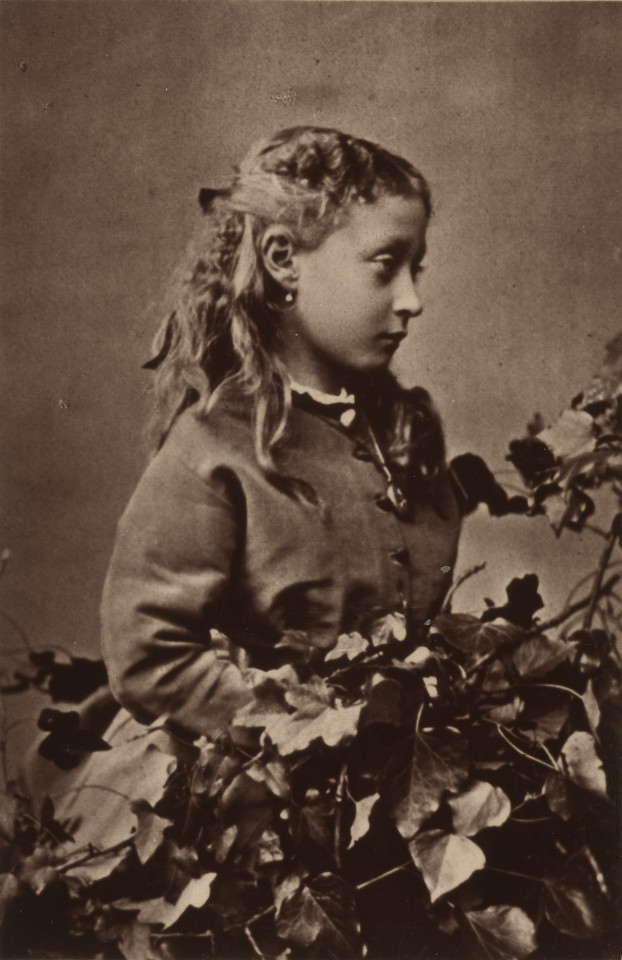
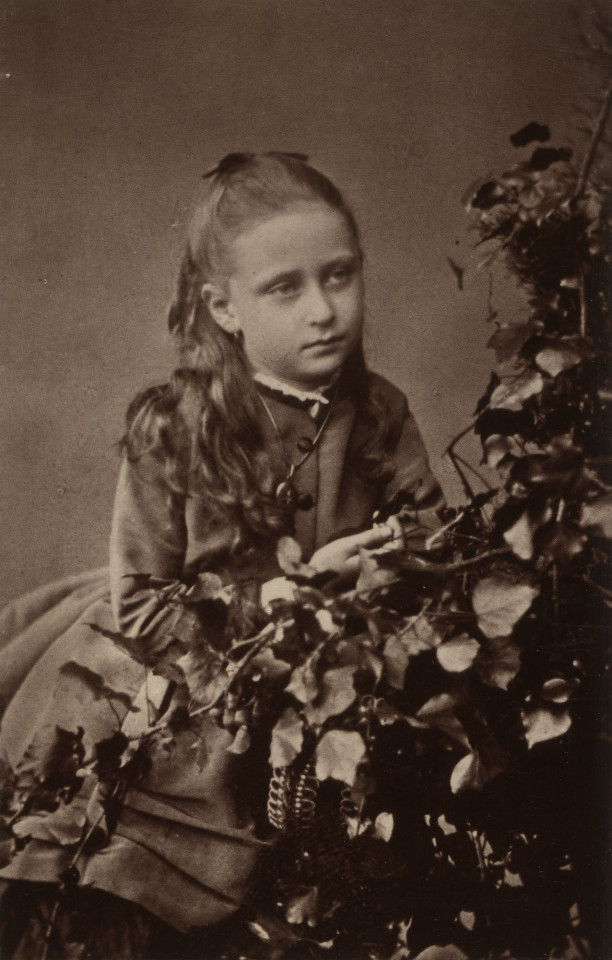
EXTREMELY rare photos of Princesses Victoria and Elisabeth of Hesse and By Rhine, early 1870s
Royal Collection Trust / © His Majesty King Charles III 2023
#SO RARE!!!#im so glad I found these!#🤍🤍🤍#princess victoria of hesse#princess elisabeth of hesse#hessian royal family#Victoria marchioness of Milford haven#princess Victoria of Battenberg#grand duchess elisabeth feodorovna#elisabeth feodorovna#elizabeth feodorovna#marchioness of Milford haven#rare photos#Hesse#ella of hesse#elisabeth of hesse#victoria of hesse#princess victoria#princess elisabeth#royal collection trust
150 notes
·
View notes
Text

Romanov relatives: Ernst-Ludwig of Hesse with his sons.
#romanov relatives#ernst ludwig of hesse#georg donatus of hesse#ludwig of hesse#ernest louis of hesse#george donatus of hesse#louis of hesse#hessian grand ducal family#my collection
43 notes
·
View notes
Text
"Flecking the hedges with red": Palmer's Ballad on the Maryland 400

A photograph of John Williamson Palmer who wrote ‘The Maryland Battalion’
Editor's note: this is an article I posted on September 28, 2016 on Finding the Maryland 400. Reposted from Academia.edu and my History Hermann WordPress blog.
In the past, we have written about poems and songs relating to the Maryland 400. [1] They were celebrated years after and during the Revolutionary War, with newspapers often containing poems and songs. Such poems included one about William Sterrett in 1776 and a song by Tom Wisner titled “The Old Line.” Poems and ballads, which are narrative poems, not only appeared in newspapers but also in books. This post analyzes the 1901 ballad titled “The Maryland Battalion in the Battle of Long Island” and its author. [2]
The ballad’s author was a native Baltimorean named John Williamson Palmer. He was a physician by profession, but later became a journalist, and served as a New York Tribune correspondent in Richmond, Virginia during the Civil War. [3] He traveled across the world to India and elsewhere in East Asia, worked for the East India Company, and warned acclaim after contributing to numerous periodicals. [4] During the Civil War, Palmer wrote the well-known ballad titled “Stonewall Jackson’s Way” during the Battle of Antietam in 1862. [5] This ballad became one of the South’s most popular lyrics. This is not surprising because Palmer joined the Confederate Army and later served on the staff of John C. Breckinridge, the Secretary of War of the Confederacy. [6] After the Civil War, he published a book of folk songs and numerous other books of note. He had become, as his former employer, the New York Tribune, called him, “a veteran balladist” who will “be long remembered” because of his good verse. [7] By the early twentieth century, some claimed that he become a writer with “vigorous lyric faculty.” [8]
“The Maryland Battalion” was originally printed in a 1902 book titled Every Day in the Year. The book was a “poetical anthology” which commemorated “the most striking events in history” and the men and women who “have left an imprint on their day and generation.” [9] The ballad was printed with an introduction making it clear it was about the Battle of Brooklyn. [10] His ballad fits with those he wrote about Stonewall Jackson and the Battle of the San Jacinto in 1836 by exhibiting a patriotic theme, from his point of view. [11]
The text of this ballad is reprinted below [12]:
Spruce Macaronis, and pretty to see,
Tidy and dapper and gallant were we;
Blooded fine gentlemen, proper and tall,
Bold in a fox-hunt and gay at a ball;
Prancing soldados so martial and bluff,
Billets for bullets, in scarlet and buff—
But our cockades were clasped with a mother’s low prayer
And the sweethearts that braided the sword-knots were
fair [13]
There was grummer of drums humming hoarse in the hills,
And the bugles sang fanfares down by the mills,
By Flatbush [14] the bagpipes were droning amain,
And keen cracked the rifles in Martense’s lane [15];
For the Hessians were flecking the hedges with red [16],
And the grenadiers’ tramp marked the roll of the dead
Three to one, flank and rear, flashed the files of St. George [17],
The fierce gleam of their steel as the glow of a forge.
The brutal boom-boom of their swart cannoneers
Was sweet music compared with the taunt of their cheers—
For the brunt of their onset, our crippled array,
And the light of God’s leading gone out in the fray.
Oh, the rout on the left and the tug on the right!
The mad plunge of the charge and the wreck of the flight!
When the cohorts of Grant [18] held stout Stirling [19] at strain,
And the mongrels of Hesse [20] went tearing the slain;
When at Freeke’s Mill the flumes and the sluices ran red,
And the dead choked the dike and the marsh choked the dead!
“Oh, Stirling, good Stirling, how long must we wait?
Shall the shout of your trumpet unleash us too late?
Have you never a dash for brave Mordecai Gist [21]
With his heart in his throat, and his blade in his fist?
Are we good for no more than to prance in a ball,
When the drums beat the charge and the clarions call?”
Tralára! Tralára! Now praise we the Lord
For the clang of His call and the flash of His sword!
Tralára! Tralára! Now forward to die;
For the banner, hurrah! and for sweethearts, good-by!
“Four hundred wild lads!” May be so. I’ll be bound
’T will be easy to count us, face up, on the ground.
If we hold the road open, though Death take the toll,
We’ll be missed on parade when the States call the roll—
When the flags meet in peace and the guns are at rest,
And fair Freedom is singing Sweet Home in the West. [22]
At the time, the ballad was positively received. Noted writer Rossiter Johnson said it reminded him of classic lyrics of another balladist, while the Chicago Tribune said that the ballad, along with his other writings, had become “familiar to the American people.” [23] The St. Louis Republic called it “blood-stirring” and the Baltimore Sun said it had no less “dash and ring” than his other ballads and would, which “rouse the blood to action and enthusiasm.” [24] Acclaimed poet Charles D. Roberts even praised it, calling it a “splendid piece of work, inevitable and unforgettable.” This flattery is not surprising because the ballad was written in style of that time by catering to a Victorian appetite for heroes and legends and preserving the Maryland 400’s story, while cultivating Maryland pride.
– Burkely Hermann, Maryland Society of the Sons of American Revolution Research Fellow, 2016.
© 2016-2023 Burkely Hermann. All rights reserved.
Notes
[1] Another post on this blog also put the ‘Midnight Ride of Paul Revere’ into context as it relates to Maryland.
[2] Alan, a volunteer at the Baltimore County Historical Society, gave me a copy of this ballad this summer when I made a trip to this historical society. In order to be consistent, the word ballad is used even though some refer to it as a poem.
[3] Henry E. Shepard, The Representative Authors of Maryland: From the Earliest Time to the Present Day With Biographical Notes and Comments Upon Their Work (New York: Whitehall Publishing Company, 1911), 100; American History Told by Contemporaries: Welding of the Nation 1845-1900 (ed. Albert Bushnell Hart, Honolulu: University Press of the Pacific, 2002, reprint of 1921 edition), 282.
[4] Rand Richards. Mud, Blood, and Gold: San Francisco in 1849 (San Francisco: Heritage House Publishers, 2008), 201; Shepard, 100; American History Told by Contemporaries, 282.
[5] Richards, 86, 101; Southern Life in Southern Literature: Selections of Representative Prose and Poetry (ed. Maurice Garland Fulton, New York: Ginn and Economy, 1917), 259-261.
[6] American History Told by Contemporaries, 282; “Words of the Hour”: A New Anthology of Civil War Poetry (ed. Faith Barrett and Cristanne Miller, Boston: University of Massachusetts Press, 2005), 389; Herman Melville, Correspondence (Chicago: Northwestern University Press, 1993), 516; Women reading Shakespeare 1660-1900: An anthology of criticism (ed. Ann Thompson and Sasha Roberts, New York: Manchester University Press, 1997), 110; Shakespeare: The Critical Tradition. The Merchant of Venice (ed. William Baker and Brian Vickers, New York: Thoemes Continuum, 2005), 86; Shepard, 100-101; Southern Life in Southern Literature, 259. Before the war, in 1855, he married Henrietta Lee, a Baltimorean who was a prolific writer and reader of Shakespeare. Palmer also had correspondence with the acclaimed novelist Herman Melville after the Civil War.
[7] “A Southern Poet.” The Evangelical Episcopalian. Vol. 14, no. 1. March 1902. pp. 464; Every Day in the Year: A Poetical Epitome of the World’s History (ed. James L. Ford and Mary K. Ford, New York: Dodd, Mead & Company, 1902), v. Others called him “one of America’s real poets,” before his death in 1906.
[8] John Wanamaker, Book News: A Monthly Survey of General Literature. Vol. 19 (Philadelphia: John Wanamaker, 1901), 684.
[9] Every Day in the Year, 289.
[10] Ibid, 133, 157-158.
[11] Poetry of the People (ed. Charles Mills Gayley and Martin C. Flaherty, Boston: Ginn & Company Publishers, 1904), 238-239; The Home Book of Verse: American and English 1580-1918 Third Edition (ed. Burton Egbert Stevenson, New York: Henry Holt and Company, 1918), 2429; Index of Current Literature (ed. Edward J. Wheeler). Vol. 40. New York: The Current Literature Publishing Company, Jan-June 1906, 449-450.
[12] The tune of this ballad is not known.
[13] “Scarlet and buff” is a reference to the uniforms Smallwood’s soldiers and said to have worn. In actuality they did not wear these uniforms. Instead, they wore white linen or hunting shirts, leather breeches, leather belts, stockings, leather shoes with buckles, and felt hats.
[14] General Sullivan was driven back by the Hessians, hired soldiers fighting for the British, and flanked by Clinton’s forces in Flatbush.
[15] Martenese’s lane was a road that was the Greenwood cemetery’s southern border in Brooklyn.
[16] As a private of the Maryland William McMillian put it in his description of the battle, “We were surrounded by Healanders [Scottish Highlanders] on one side, Hessians on the other.”
[17] The “files of St. George” are British soldiers.
[18] A British general named James Grant commanded the left wing during the battle.
[19] Lord Stirling, or William Alexander, was a veteran of the Seven Years War, and was a brigadier general during the battle.
[20] Refers to Hessians.
[21] Mordecai Gist was a native Baltimorean and commanded the Marylanders during the Battle.
[22] The last lines are saying that people should fight at any cost for their freedom and is challenging readers to fight and not be weak.
[23] The Missionary Review of the World vol. 24, part 2. Funk & Wagnalls, 1901, 160.
[24] The Missionary Review of the World, 115, 160, 181-182; The Literary Digest Vol. XXII, no. 25. June 22, 1901, 1A2.
#maryland 400#john williamson palmer#poems#revolutionary war#mordecai gist#patriotism#confederacy#civil war#hessians#germany
0 notes
Text

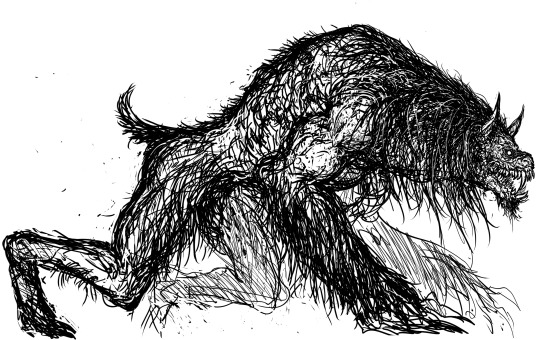
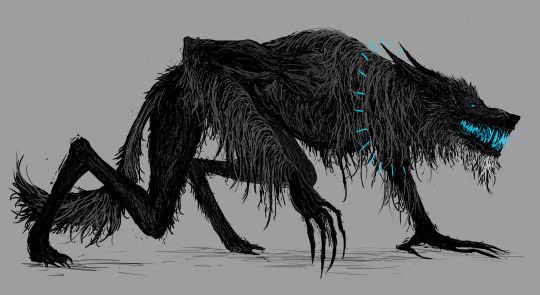
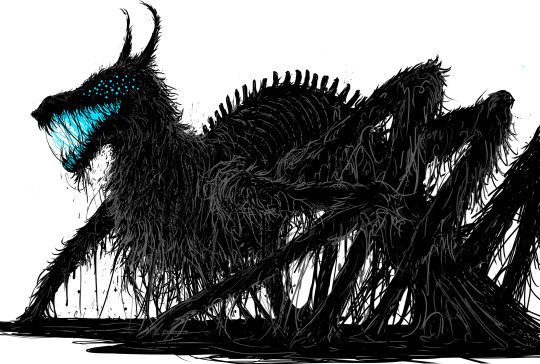
GARM sub-programs (Hessian's field guide)
TEUFELSHUNDE - Vanguard fighters, hulking brutes. Powerful regeneration, better to burn them.
OLD GREY BEARDS - Veteran Alphas. Sneaky bastards. Slower regeneration but clever.
WILD SHUKK - Recent permutations. Multi-eyed Mongrel shapeshifters.
1K notes
·
View notes